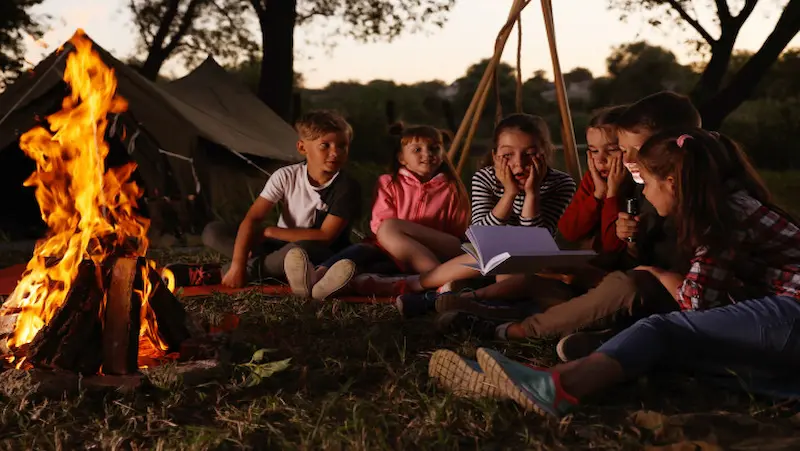Scary stories have long captivated the imaginations of children, offering a unique allure that continues to enthrall young minds. While the idea of frightening tales may seem counterintuitive to promoting a sense of safety and well-being, the benefits of scary stories for kids are surprisingly manifold.
These eerie narratives, filled with ghosts, monsters, and unexplained phenomena, hold a special place in children’s literature and storytelling traditions, catering to their innate fascination with the unknown and the thrilling. In this article, we will delve into the allure of scary bedtime stories for kids and explore the various benefits they provide, including the development of resilience, the cultivation of imagination, and the exploration of emotions in a controlled environment.
By understanding the value of these spine-chilling tales, parents, educators, and storytellers can embrace the power of fear as a tool for growth and enrichment in a child’s world.
Table of contents
What Makes a Scary Story Kid-Friendly
Scary stories have a captivating allure, weaving a tapestry of spine-tingling suspense and thrill. While typically aimed at adult audiences, the genre has evolved to cater to children as well. Crafting scary stories for young readers requires a delicate balance, ensuring an age-appropriate experience without overwhelming them.
In this blog, we’ll explore the key elements that make scary stories suitable and enjoyable for children, fostering their imagination and love for literature.

Age-Appropriate Fears
Children have their own set of fears, distinct from those of adults. Effective scary stories for children tap into these age-appropriate fears, often centered around common childhood anxieties such as darkness, monsters, ghosts, or the unknown. By addressing these fears in a controlled and imaginative manner, children can explore and conquer their own apprehensions within a safe fictional context.
Engaging Characters
Engaging characters are at the heart of any captivating story. In scary tales for children, relatable protagonists serve as beacons of courage and resilience, empowering young readers to face their fears. These characters should possess qualities that resonate with children, such as curiosity, resourcefulness, and bravery. By identifying with these characters, children find inspiration and reassurance that they too can overcome challenges.
Sense of Wonder and Imagination
Scary stories for children often intertwine elements of fantasy and imagination, transporting young readers into mysterious worlds that coexist with their own reality. Magical creatures, enchanted objects, or extraordinary settings spark a sense of wonder and curiosity, inviting children to explore new realms of imagination. This blend of fantasy and fear provides a safe space for children to delve into the unknown while nurturing their creativity.
Gentle Build-Up of Tension
Children may not have the same tolerance for intense suspense as adults do. Therefore, scary stories for young readers employ a gentle build-up of tension. This gradual progression allows children to become emotionally invested in the story for kids without overwhelming them. By balancing moments of suspense with lighter or humorous interludes, authors create a rhythm that keeps young readers engaged and provides much-needed relief when tension peaks.
Positive Resolution
It is essential that scary stories for children offer a positive resolution. After all, the purpose is not to traumatize, but rather to entertain and teach valuable lessons. A satisfying ending, where the protagonists triumph over their fears or discover that what seemed scary was, in fact, harmless, reinforces the idea that courage and resilience can lead to favorable outcomes. This conclusion reassures children that they can confront their own fears and emerge victorious.
Teachable Moments
Scary stories can serve as powerful tools for imparting valuable life lessons. These tales often contain themes of friendship, empathy, problem-solving, and personal growth. By incorporating these teachable moments, scary stories become more than just thrilling narratives; they become vehicles for moral and emotional development. Children can learn empathy by understanding the motivations of scary characters or problem-solving skills by observing how the protagonists overcome challenges.
The Importance of Age-Appropriate Content
As parents, we often encourage our children to explore the wonders of literature, including the captivating genre of scary stories. These tales of suspense, mystery, and the supernatural can ignite their imagination and provide a thrilling experience. However, it is essential to consider the age and maturity level of our children when selecting such stories.
In this blog post, we will discuss why it is crucial to choose scary stories that match your child’s age and maturity level, ensuring a positive thinking for kids and age-appropriate experience.

Emotional well-being and psychological impact
Young minds are highly impressionable, and exposure to inappropriate or excessively frightening content can have a lasting impact on their emotional well-being. Scary stories that exceed a child’s development emotional maturity level can lead to nightmares, anxiety, and even long-term fear or trauma. By selecting stories that match their age and maturity, we can help prevent potential negative effects on their mental health.
Promoting a positive reading experience
Reading for kids should be an enjoyable and engaging experience for children, fostering a love for literature and storytelling. When we choose scary stories that align with their age and maturity, we can create a positive reading experience. Stories that are too complex or terrifying may overwhelm them, causing them to lose interest or associate reading with fear. Age-appropriate selections can captivate their attention and provide an appropriate level of excitement and suspense.
Encouraging comprehension and understanding
Scary stories often contain themes and concepts that require a certain level of cognitive ability to comprehend fully. Children at different stages of development may struggle to grasp complex ideas or follow intricate plotlines. By selecting stories that align with their cognitive abilities, we can ensure they can comprehend and engage with the story effectively. This promotes their overall reading comprehension skills and encourages them to develop critical thinking abilities.
Fostering resilience and coping skills
Exposing children to age-appropriate scary stories can serve as a valuable opportunity for them to learn about fear and develop coping mechanisms. Stories that are too intense can overwhelm their coping abilities and hinder their emotional growth. By choosing stories that gradually introduce suspense and fear in a manageable way, we can help children build resilience and develop strategies for managing their fears.
Parental guidance and open communication
When selecting scary stories, it is crucial for parents to actively participate in their children’s reading experience. By discussing the themes, characters, and events in the story, parents can provide guidance and help children navigate any fears or concerns that may arise. Open communication allows parents to monitor their child’s reactions and adjust the reading material accordingly, ensuring a safe and positive experience.
Top 10 Spooky and Engaging Scary Stories for Kids
Children have a remarkable capacity for imagination, and what better way to stimulate their creativity and thrill their senses than with a good scare? Scary stories for kids have been a beloved genre for generations, capturing the imagination and providing a safe space to experience fear and excitement.
In this blog, we present a list of the top 10 best scary stories for kids. Each story will be accompanied by a brief summary and an explanation of why it is recommended. So, gather around, brave souls, as we embark on a spine-tingling journey!

“Scary Stories to Tell in the Dark” by Alvin Schwartz
This iconic collection of spooky tales combines folklore and urban legends to create a bone-chilling experience. With its eerie illustrations by Stephen Gammell, this series is a must-read for children who enjoy hair-raising stories. These tales are perfect for introducing kids to the thrill of being scared.
“Coraline” by Neil Gaiman
In this dark fantasy, Coraline discovers a secret door in her new house that leads to a parallel world. What seems initially appealing soon turns into a terrifying ordeal as she encounters an “Other Mother” who wants to keep her forever. Gaiman’s vivid storytelling and memorable characters make this a captivating and eerie read.
“Goosebumps” series by R.L. Stine
R.L. Stine’s Goosebumps series has been a staple of children’s horror for decades. With over 60 books to choose from, these stories cover a wide range of spooky themes and creatures. Each book offers a thrilling adventure that keeps readers hooked and begging for more.
“The Witches” by Roald Dahl
Roald Dahl’s classic tale introduces us to the terrifying world of witches. When a young boy stumbles upon a gathering of witches, he uncovers their wicked plan to turn all children into mice. Dahl’s masterful storytelling combines humor and fear, making it a timeless favorite.
“Wait Till Helen Comes” by Mary Downing Hahn
This ghostly tale follows a blended family that moves into an old church-turned-house, haunted by the vengeful spirit of Helen. As Heather, the protagonist’s stepsister, becomes increasingly influenced by the ghost, the tension rises. Hahn’s atmospheric storytelling keeps readers on the edge of their seats.
“The Graveyard Book” by Neil Gaiman
In this enchanting and macabre tale, a boy named Nobody Owens is raised by ghosts in a graveyard. As he grows up, he becomes entangled in a battle between the living and the dead. Gaiman’s imaginative storytelling and unique characters make this a spooky but heartwarming read.
“The Dollhouse Murders” by Betty Ren Wright
When Amy discovers a dollhouse in the attic that eerily mirrors the murders of her ancestors, she becomes obsessed with solving the mystery. As she delves deeper into the past, strange occurrences and spectral encounters ensue. This suspenseful story will keep readers guessing until the very end.
“The House with a Clock in Its Walls” by John Bellairs
Young Lewis Barnavelt moves into his uncle’s mysterious house and soon discovers its dark secrets. With a ticking clock hidden within the walls, Lewis finds himself entangled in a race against time to prevent a terrible disaster. Bellairs’ gothic style and vivid descriptions make this a thrilling read.
“Wait ‘Till Helen Comes: A Ghost Story” by Mary Downing Hahn
When Molly and her family move into an old converted church, they encounter the ghostly presence of Helen. Molly’s younger stepsister, Heather, is particularly drawn to the ghost, leading to a suspenseful and haunting tale. This chilling story explores themes of friendship, forgiveness, and the supernatural.
“Scary Stories for Young Foxes” by Christian McKay Heidicker
Set in a world of anthropomorphic animals, this collection of interconnected stories follows a group of young foxes who venture into the dangerous woods. Each story is an engaging and spooky adventure that explores themes of bravery and friendship. Heidicker’s atmospheric writing makes it a compelling read.
Tips for Engaging Storytelling
Storytelling is a magical activity that has captivated audiences for centuries. It not only stimulates a child’s imagination but also nurtures their language skills, creativity, and emotional development. As a parent, you have the wonderful opportunity to create memorable storytelling sessions for your children.
In this blog, we will explore some tips and techniques to make your storytelling sessions more interactive and engaging, fostering a love for stories and learning in your little ones.

Choose captivating stories
Select stories that align with your child’s interests, age, and developmental stage. Engaging narratives with vibrant characters, exciting plotlines, and relatable themes can instantly capture their attention. Picture books or interactive story apps can be excellent choices for younger children, while older kids might enjoy chapter books or myths and legends.
Incorporate expressive voice and gestures
Bring the characters to life by using expressive voices, varying tones, and gestures while narrating the story. Adapt your voice to match the characters’ personalities, and don’t be afraid to be animated! Encourage children to join in by imitating the voices or acting out specific scenes. This interactive approach enhances their engagement and fosters their creativity.
Encourage participation and imagination
Involve children in the storytelling process by encouraging them to participate actively. Ask open-ended questions, such as “What do you think happens next?” or “How would you feel if you were the main character?” This fosters their imagination and critical thinking skills, allowing them to develop their own interpretations and ideas about the story.
Utilize props and visual aids
Visual aids can add an extra layer of excitement to storytelling sessions. Use props, puppets, or even simple drawings to illustrate key elements of the story. For example, you could create a puppet theater for retelling fairy tales or use flashcards to introduce new characters. These props provide a multisensory experience that enhances the children’s understanding and involvement in the narrative.
Integrate music and sound effects
Incorporate music and sound effects to enhance the storytelling experience. Play soft background music to set the mood or use sound effects to create a sense of adventure or mystery. You can find a variety of resources online, including ambient soundscapes or themed playlists. Music and sound effects evoke emotions and immerse children in the story world, making it more captivating and memorable.
Explore interactive storytelling formats
Step beyond traditional storytelling formats and explore interactive alternatives. Try “choose-your-own-adventure” stories, where children decide the protagonist’s actions, or create story-based treasure hunts, where they follow clues to unravel the plot. These interactive formats not only make storytelling sessions more engaging but also develop problem-solving skills and critical thinking in children.
Connect stories to real-life experiences
Relate the stories to your child’s own experiences or the world around them. Discuss the lessons or morals embedded within the story and encourage conversations about how the characters’ actions can be applied in real life. This connection strengthens the child’s comprehension and empathy while fostering their ability to draw meaningful connections between stories and their own lives.
Establish a consistent storytelling routine
Consistency is key when it comes to engaging storytelling sessions. Establish a regular storytelling routine, such as before bedtime or during family gatherings. By making storytelling a predictable and cherished event, children will eagerly anticipate and actively participate in each session.
Conclusion
In conclusion, scary short stories for kids offer a range of benefits that go beyond mere entertainment. These tales provide valuable opportunities for children to explore their emotions, develop critical thinking skills, and cultivate resilience in a safe and controlled environment. By engaging with spooky narratives, children can learn to confront and overcome their fears, building confidence and inner strength along the way.
Furthermore, scary stories foster imagination and creativity in children. They ignite a sense of wonder, encouraging young minds to think beyond the ordinary and explore the realms of the unknown. By exposing children to different narrative structures and suspenseful plotlines, these stories help to develop their storytelling abilities and enhance their cognitive capacities.
Parents, it is essential to recognize the educational and developmental value of scary stories for your children. Rather than shielding them from the realm of the eerie, embrace these tales as powerful tools for growth and learning. By providing a rich tapestry of spooky narratives, you can stimulate your child’s imagination, foster emotional intelligence, and promote critical thinking skills.
Encouragingly, there are countless excellent scary stories available for kids to explore. From classic folklore to contemporary authors, the options are vast. Consider introducing your child to timeless tales like “Scary Stories to Tell in the Dark” by Alvin Schwartz or the works of R.L. Stine, such as the beloved “Goosebumps” series. Additionally, explore online platforms and local libraries for curated collections and recommendations suited to your child’s age group.
To know more about coding courses for kids and coding class for kids follow our blog page!
Remember, by embracing scary stories, you offer your children a gift—an invitation to a world where imagination, growth, and courage intertwine. So, embark on this thrilling journey with your little ones and watch as they flourish in the face of the unknown.
BrightChamps offers interesting and fun robotics projects for kids, combining learning and play while igniting their passion for technology. Explore the world of robotics and discover a bright future with us!
By fostering creativity, instilling financial literacy, and honing coding skills, BrightChamps equips young learners with the tools they need to excel in an ever-evolving world. Join us in shaping tomorrow’s leaders today – because at BrightChamps, every child’s potential shines brilliantly.
Frequently Asked Questions
A1: Absolutely! Our scary stories for kids are specifically curated to be age-appropriate, ensuring that they provide just the right amount of thrill without being overly frightening.
A2: These scary stories for kids are designed to spark creativity and imagination. Encourage your child to visualise the scenes, discuss the characters, or even create their own alternate endings.
A3: Yes, indeed! Our scary stories make for excellent bedtime reading. They offer a thrilling yet safe experience that will capture your child’s attention while still allowing them to sleep peacefully.
A4: Absolutely! These stories are perfect for spooky-themed gatherings, slumber parties, or Halloween events. Just gather the children around, dim the lights, and let the storytelling begin!















